Impact of the Area of Residence of Ovarian Cancer Patients on Overall Survival
Abstract
:Simple Summary
Abstract
1. Introduction
2. Materials and Methods
2.1. Patient Selection
2.2. Clinical and Sociodemographic Variables
2.3. Outcome Measurement
2.4. Statistical Analysis
3. Results
3.1. Patient Characteristics
3.2. County Clusters
3.3. Survival Analysis
4. Discussion
5. Conclusions
Supplementary Materials
Author Contributions
Funding
Institutional Review Board Statement
Informed Consent Statement
Data Availability Statement
Conflicts of Interest
References
- Siegel, R.L.; Miller, K.D.; Fuchs, H.E.; Jemal, A. Cancer statistics, 2022. CA Cancer J. Clin. 2022, 72, 7–33. [Google Scholar] [CrossRef]
- Bristow, R.E.; Powell, M.A.; Al-Hammadi, N.; Chen, L.; Miller, J.P.; Roland, P.Y.; Mutch, D.G.; Cliby, W.A. Disparities in Ovarian Cancer Care Quality and Survival According to Race and Socioeconomic Status. J. Natl. Cancer Inst. 2013, 105, 823–832. [Google Scholar] [CrossRef] [Green Version]
- Ellis, L.; Canchola, A.J.; Spiegel, D.; Ladabaum, U.; Haile, R.; Gomez, S.L. Racial and Ethnic Disparities in Cancer Survival: The Contribution of Tumor, Sociodemographic, Institutional, and Neighborhood Characteristics. J. Clin. Oncol. 2018, 36, 25–33. [Google Scholar] [CrossRef] [PubMed]
- Gomez, S.L.; Shariff-Marco, S.; DeRouen, M.; Keegan, T.H.M.; Yen, I.H.; Mujahid, M.; Satariano, W.A.; Glaser, S.L. The Impact of Neighborhood Social and Built Environment Factors across the Cancer Continuum: Current Research, Methodological Considerations, and Future Directions. Cancer 2015, 121, 2314–2330. [Google Scholar] [CrossRef] [PubMed] [Green Version]
- Russell, E.F.; Kramer, M.R.; Cooper, H.L.F.; Gabram-Mendola, S.; Senior-Crosby, D.; Jacob Arriola, K.R. Metropolitan Area Racial Residential Segregation, Neighborhood Racial Composition, and Breast Cancer Mortality. Cancer Causes Control 2012, 23, 1519–1527. [Google Scholar] [CrossRef] [PubMed]
- Pruitt, S.L.; Lee, S.J.C.; Tiro, J.A.; Xuan, L.; Ruiz, J.M.; Inrig, S. Residential Racial Segregation and Mortality among Black, White, and Hispanic Urban Breast Cancer Patients in Texas, 1995 to 2009. Cancer 2015, 121, 1845–1855. [Google Scholar] [CrossRef] [PubMed] [Green Version]
- Russell, E.; Kramer, M.R.; Cooper, H.L.F.; Thompson, W.W.; Arriola, K.R.J. Residential Racial Composition, Spatial Access to Care, and Breast Cancer Mortality among Women in Georgia. J. Urban Health 2011, 88, 1117–1129. [Google Scholar] [CrossRef] [Green Version]
- Haan, M.; Kaplan, G.A.; Camacho, T. Poverty and Health. Prospective Evidence from the Alameda County Study. Am. J. Epidemiol. 1987, 125, 989–998. [Google Scholar] [CrossRef] [PubMed]
- Brewer, K.C.; Peterson, C.E.; Davis, F.G.; Hoskins, K.; Pauls, H.; Joslin, C.E. The Influence of Neighborhood Socioeconomic Status and Race on Survival from Ovarian Cancer: A Population-Based Analysis of Cook County, Illinois. Ann. Epidemiol. 2015, 25, 556–563. [Google Scholar] [CrossRef] [PubMed] [Green Version]
- Joslin, C.E.; Brewer, K.C.; Davis, F.G.; Hoskins, K.; Peterson, C.E.; Pauls, H.A. The Effect of Neighborhood-Level Socioeconomic Status on Racial Differences in Ovarian Cancer Treatment in a Population-Based Analysis in Chicago. Gynecol. Oncol. 2014, 135, 285–291. [Google Scholar] [CrossRef] [PubMed]
- Peterson, C.E.; Rauscher, G.H.; Johnson, T.P.; Kirschner, C.V.; Barrett, R.E.; Kim, S.; Fitzgibbon, M.L.; Joslin, C.E.; Davis, F.G. The Association between Neighborhood Socioeconomic Status and Ovarian Cancer Tumor Characteristics. Cancer Causes Control 2014, 25, 633–637. [Google Scholar] [CrossRef] [PubMed]
- Westrick, A.C.; Bailey, Z.D.; Schlumbrecht, M.; Hlaing, W.M.; Kobetz, E.E.; Feaster, D.J.; Balise, R.R. Residential Segregation and Overall Survival of Women with Epithelial Ovarian Cancer. Cancer 2020, 126, 3698–3707. [Google Scholar] [CrossRef] [PubMed]
- O’Malley, C.; Cress, R.; Campleman, S.; Leiserowitz, G. Survival of Californian Women with Epithelial Ovarian Cancer, 1994-1996: A Population-Based Study. Gynecol. Oncol. 2004, 91, 608–615. [Google Scholar] [CrossRef] [PubMed]
- National Cancer Institute, DCCPS. Surveillance, Epidemiology, and End Results (SEER) Program Research Data (1975–2016). Available online: https://seer.cancer.gov/ (accessed on 4 September 2022).
- Murtagh, F.; Contreras, P. Methods of Hierarchical Clustering. arXiv 2011, arXiv:1105.0121. [Google Scholar]
- Lever, J.; Krzywinski, M.; Altman, N. Principal Component Analysis. Nat. Methods 2017, 14, 641–642. [Google Scholar] [CrossRef] [Green Version]
- Husson, F.; Josse, J.; Pagès, J. Principal Component Methods—Hierarchical Clustering—Partitional Clustering: Why Would We Need to Choose for Visualizing Data? 2010. Available online: http://www.sthda.com/english/upload/hcpc_husson_josse.pdf (accessed on 4 September 2022).
- Ward, J.H. Hierarchical Grouping to Optimize an Objective Function. J. Am. Stat. Assoc. 1963, 58, 236–244. [Google Scholar] [CrossRef]
- Afshar, N.; English, D.R.; Milne, R.L. Factors Explaining Socio-Economic Inequalities in Cancer Survival: A Systematic Review. Cancer Control 2021, 28, 10732748211011956. [Google Scholar] [CrossRef] [PubMed]
- Woods, L.M.; Rachet, B.; Coleman, M.P. Origins of Socio-Economic Inequalities in Cancer Survival: A Review. Ann. Oncol. 2006, 17, 5–19. [Google Scholar] [CrossRef] [PubMed]
- Mahdi, H.; Kumar, S.; Munkarah, A.R.; Abdalamir, M.; Doherty, M.; Swensen, R. Prognostic Impact of Marital Status on Survival of Women with Epithelial Ovarian Cancer. Psychooncology 2013, 22, 83–88. [Google Scholar] [CrossRef]
- Halpern, M.T.; Ward, E.M.; Pavluck, A.L.; Schrag, N.M.; Bian, J.; Chen, A.Y. Association of Insurance Status and Ethnicity with Cancer Stage at Diagnosis for 12 Cancer Sites: A Retrospective Analysis. Lancet Oncol. 2008, 9, 222–231. [Google Scholar] [CrossRef]
- Ibfelt, E.H.; Dalton, S.O.; Høgdall, C.; Fagö-Olsen, C.L.; Steding-Jessen, M.; Osler, M.; Johansen, C.; Frederiksen, K.; Kjær, S.K. Do Stage of Disease, Comorbidity or Access to Treatment Explain Socioeconomic Differences in Survival after Ovarian Cancer?—A Cohort Study among Danish Women Diagnosed 2005–2010. Cancer Epidemiol. 2015, 39, 353–359. [Google Scholar] [CrossRef] [PubMed]
- Kitchener, H.C. Survival from Cancer of the Ovary in England and Wales up to 2001. Br. J. Cancer 2008, 99, S73–S74. [Google Scholar] [CrossRef] [PubMed]
- Louwman, W.J.; Aarts, M.J.; Houterman, S.; van Lenthe, F.J.; Coebergh, J.W.W.; Janssen-Heijnen, M.L.G. A 50% Higher Prevalence of Life-Shortening Chronic Conditions among Cancer Patients with Low Socioeconomic Status. Br. J. Cancer 2010, 103, 1742–1748. [Google Scholar] [CrossRef] [PubMed]
- Sperling, C.; Noer, M.C.; Christensen, I.J.; Nielsen, M.L.S.; Lidegaard, Ø.; Høgdall, C. Comorbidity Is an Independent Prognostic Factor for the Survival of Ovarian Cancer: A Danish Register-Based Cohort Study from a Clinical Database. Gynecol. Oncol. 2013, 129, 97–102. [Google Scholar] [CrossRef] [PubMed]
- Tetsche, M.S.; Dethlefsen, C.; Pedersen, L.; Sorensen, H.T.; Norgaard, M. The Impact of Comorbidity and Stage on Ovarian Cancer Mortality: A Nationwide Danish Cohort Study. BMC Cancer 2008, 8, 31. [Google Scholar] [CrossRef] [Green Version]
- O’Malley, C.D.; Shema, S.J.; Cress, R.D.; Bauer, K.; Kahn, A.R.; Schymura, M.J.; Wike, J.M.; Stewart, S.L. The Implications of Age and Comorbidity on Survival Following Epithelial Ovarian Cancer: Summary and Results from a Centers for Disease Control and Prevention Study. J. Women’s Health 2012, 21, 887–894. [Google Scholar] [CrossRef]
- Abdel-Rahman, M.E.; Butler, J.; Sydes, M.R.; Parmar, M.K.B.; Gordon, E.; Harper, P.; Williams, C.; Crook, A.; Sandercock, J.; Swart, A.M.; et al. No Socioeconomic Inequalities in Ovarian Cancer Survival within Two Randomised Clinical Trials. Br. J. Cancer 2014, 111, 589–597. [Google Scholar] [CrossRef] [Green Version]
- Villanueva, C.; Chang, J.; Ziogas, A.; Bristow, R.E.; Vieira, V.M. Ovarian Cancer in California: Guideline Adherence, Survival, and the Impact of Geographic Location, 1996-2014. Cancer Epidemiol. 2020, 69, 101825. [Google Scholar] [CrossRef]
- Daruvala, A.; Lucas, F.L.; Sammon, J.; Darus, C.; Bradford, L. Impact of Geography and Travel DistancIn Proceedings of thee on Outcomes in Epithelial Ovarian Cancer: A National Cancer Database Analysis. Int. J. Gynecol. Cancer 2021, 31, 209–214. [Google Scholar] [CrossRef]

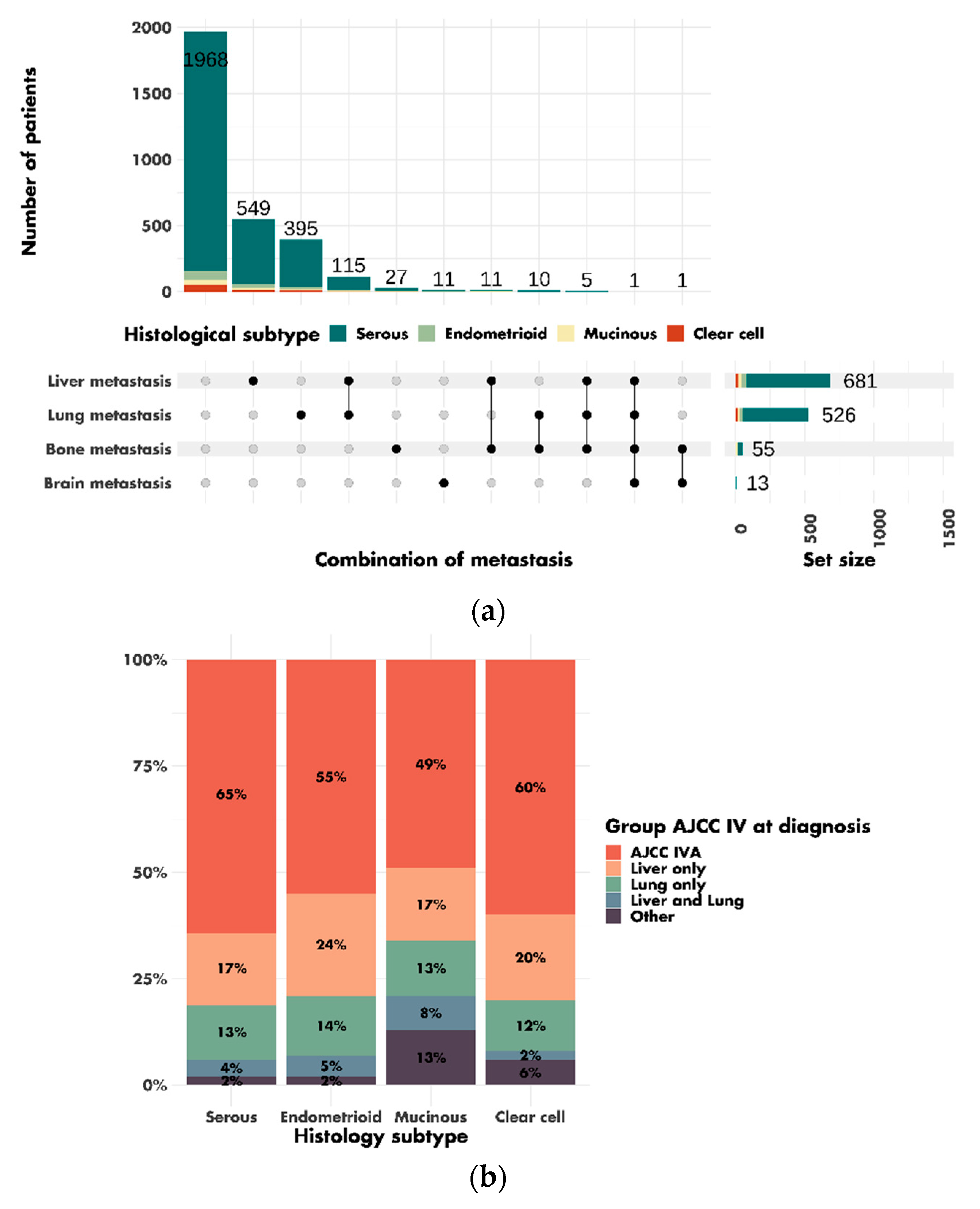
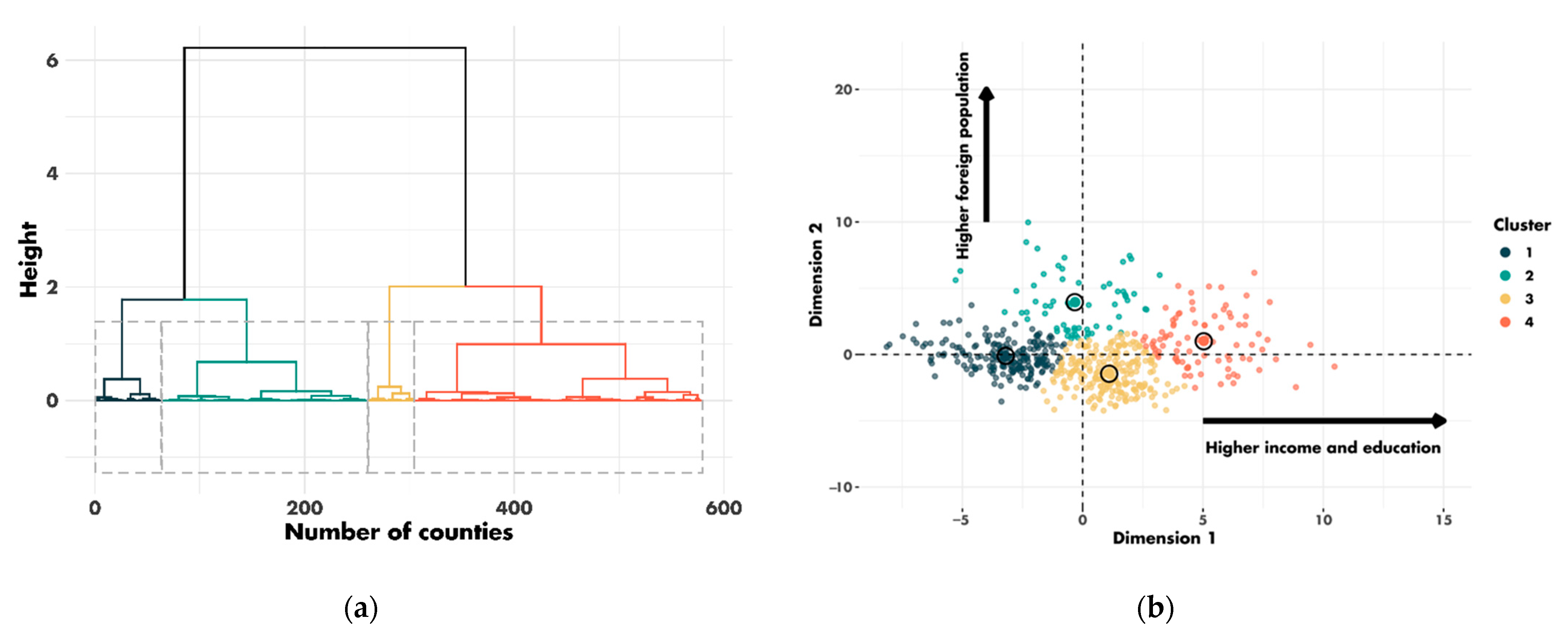


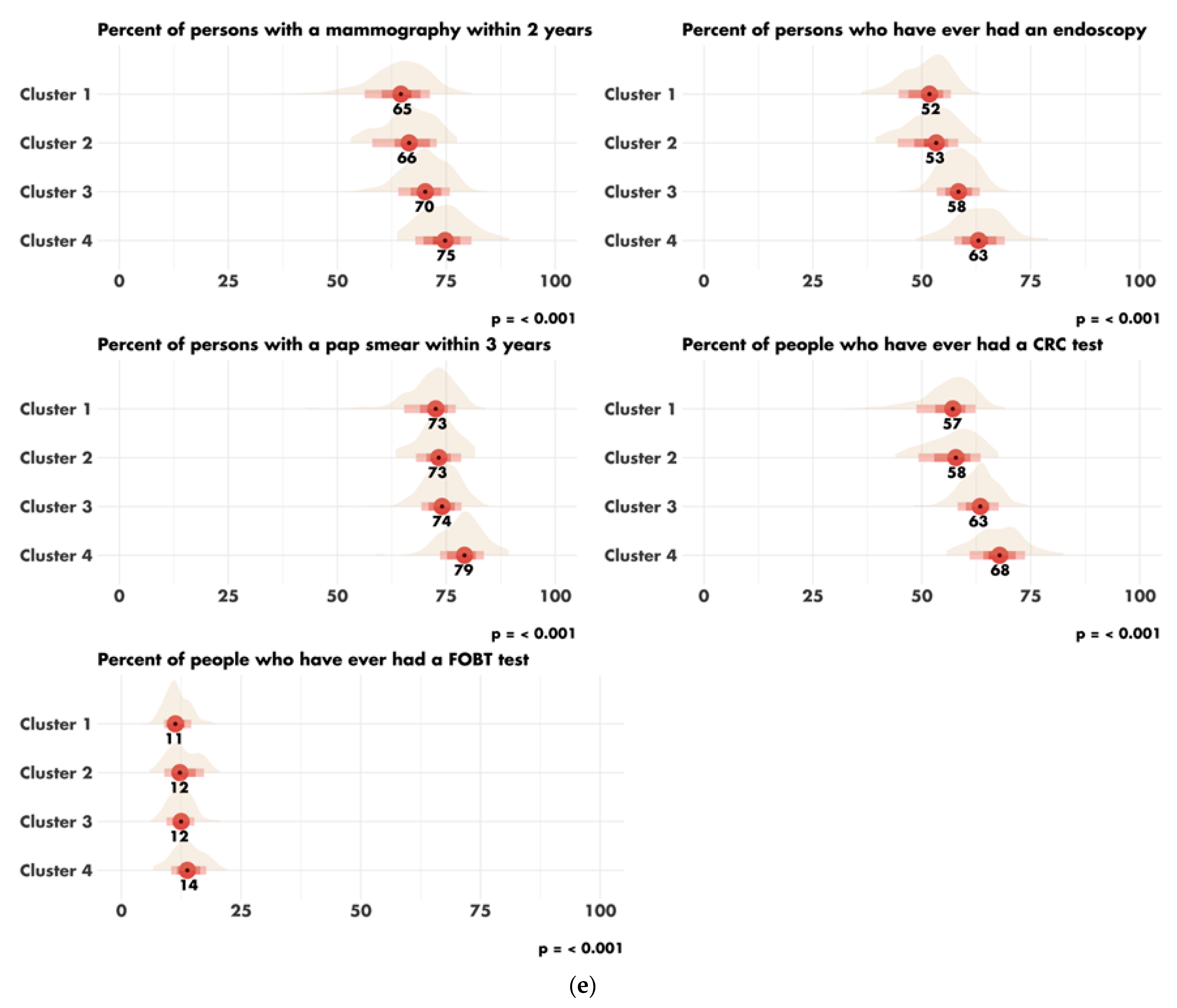
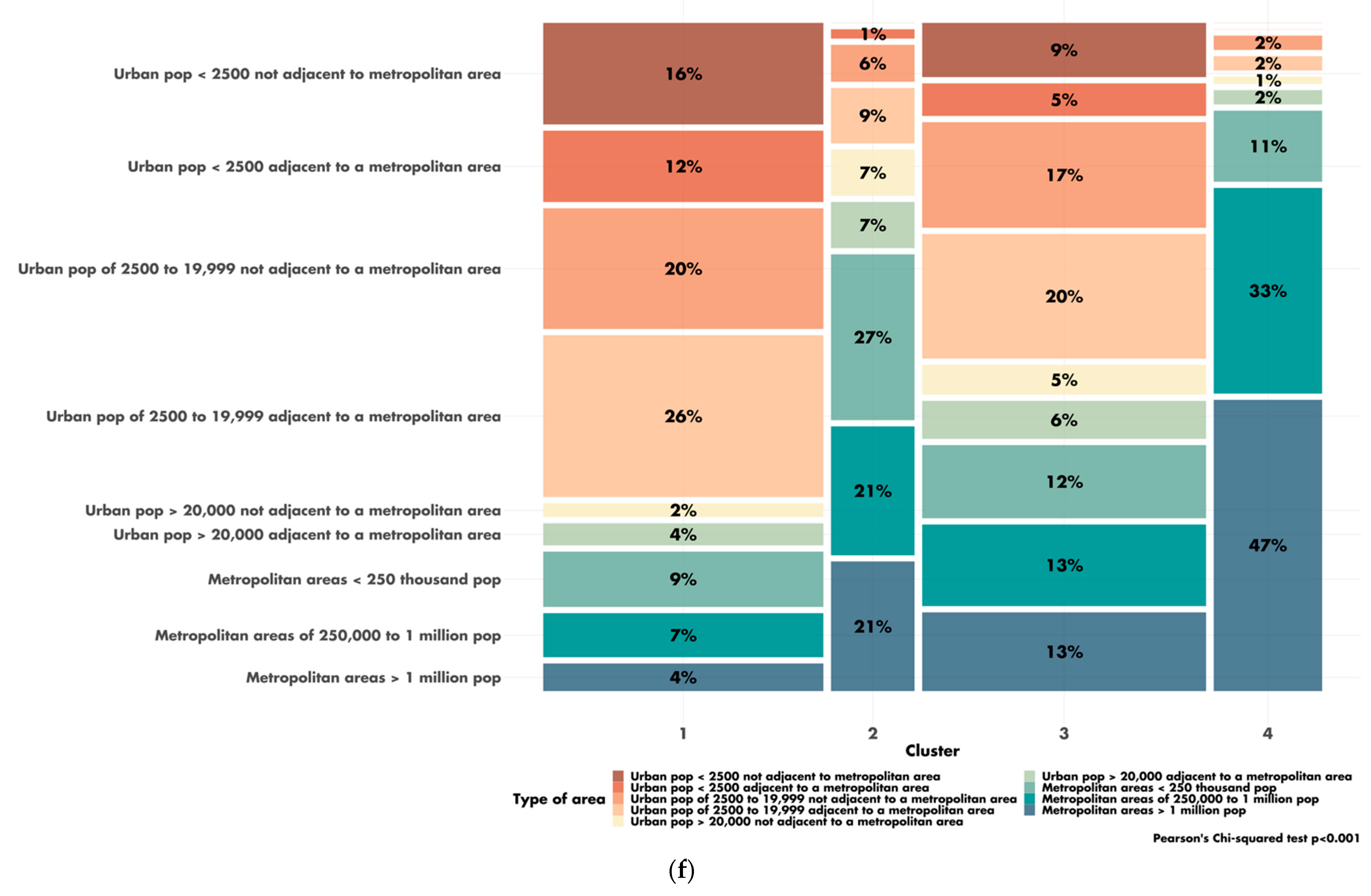

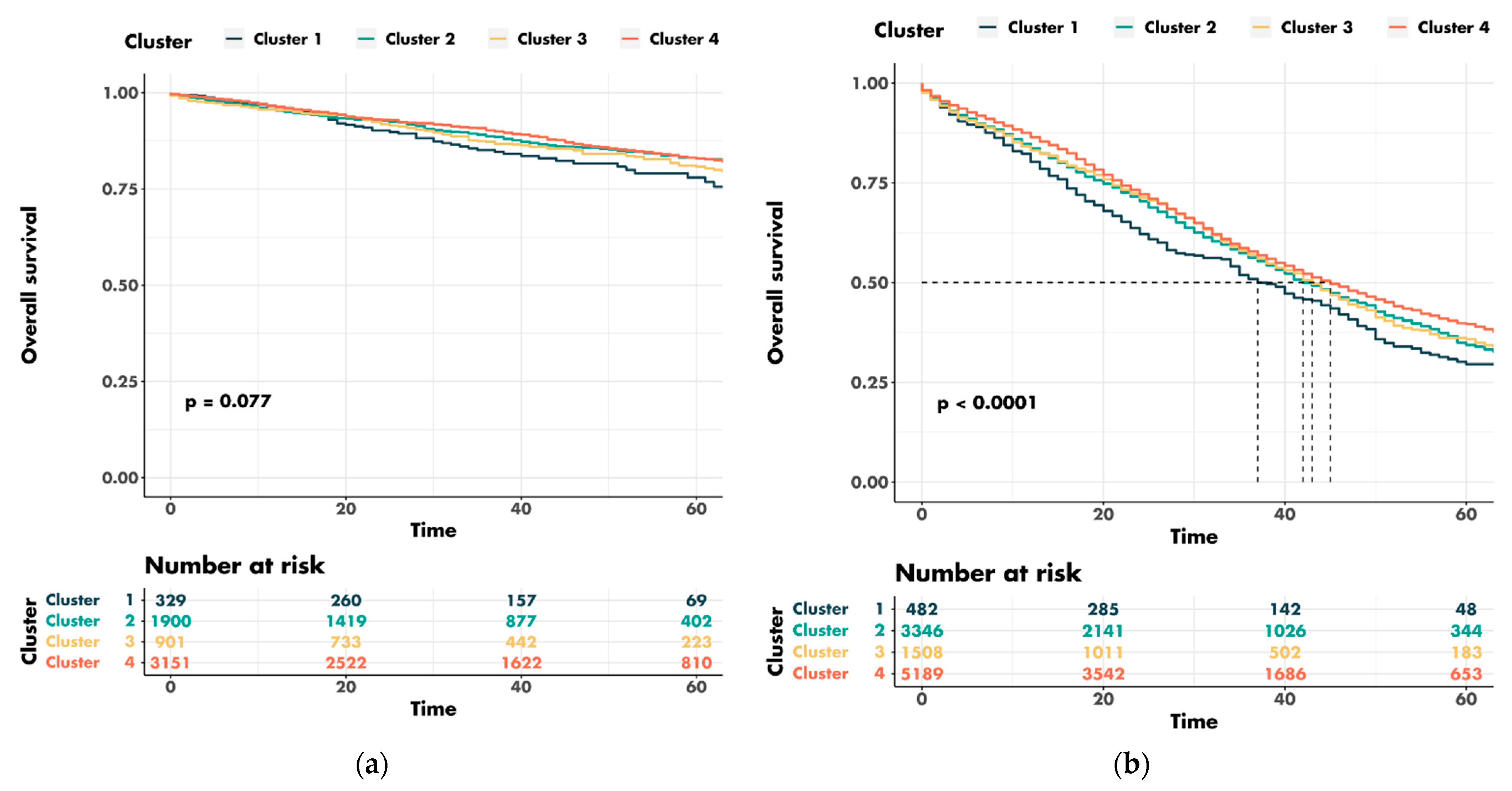

| Variable | Overall | Cluster 1 | Cluster 2 | Cluster 3 | Cluster 4 | p | |
|---|---|---|---|---|---|---|---|
| n | 16,806 | 811 (4.8) | 5246 (31.2) | 2409 (14.3) | 8340 (49.6) | ||
| Patient age (y) | 60.7 (13.0) | 61.5 (12.9) | 60.0 (13.1) | 61.9 (12.8) | 60.8 (12.9) | <0.001 | |
| Patient age class (y) | <40 | 853 (5.1) | 46 (5.7) | 305 (5.8) | 104 (4.3) | 398 (4.8) | <0.001 |
| 40–49 | 2312 (13.8) | 90 (11.1) | 771 (14.7) | 286 (11.9) | 1165 (14.0) | ||
| 50–59 | 4564 (27.2) | 203 (25.0) | 1453 (27.7) | 604 (25.1) | 2304 (27.6) | ||
| 60–74 | 6558 (39.0) | 349 (43.0) | 1975 (37.6) | 1020 (42.3) | 3214 (38.5) | ||
| ≥75 | 2519 (15.0) | 123 (15.2) | 742 (14.1) | 395 (16.4) | 1259 (15.1) | ||
| Ethnicity | NH white | 11,866 (70.6) | 665 (82.0) | 2916 (55.6) | 2118 (87.9) | 6167 (73.9) | <0.001 |
| NH American Indian/Alaska native | 96 (0.6) | 5 (0.6) | 48 (0.9) | 13 (0.5) | 30 (0.4) | ||
| NH Asian or Pacific islander | 1564 (9.3) | 7 (0.9) | 510 (9.7) | 45 (1.9) | 1002 (12.0) | ||
| NH black | 1105 (6.6) | 98 (12.1) | 481 (9.2) | 138 (5.7) | 388 (4.7) | ||
| Hispanic (All races) | 2136 (12.7) | 35 (4.3) | 1278 (24.4) | 94 (3.9) | 729 (8.7) | ||
| Marital status | Married | 8950 (53.3) | 428 (52.8) | 2594 (49.4) | 1354 (56.2) | 4574 (54.8) | <0.001 |
| Single (never married) | 3230 (19.2) | 125 (15.4) | 1226 (23.4) | 353 (14.7) | 1526 (18.3) | ||
| Unmarried or living with a partner | 73 (0.4) | 2 (0.2) | 25 (0.5) | 4 (0.2) | 42 (0.5) | ||
| Divorced | 1731 (10.3) | 76 (9.4) | 523 (10.0) | 239 (9.9) | 893 (10.7) | ||
| Separated | 165 (1.0) | 7 (0.9) | 76 (1.4) | 18 (0.7) | 64 (0.8) | ||
| Widowed | 1960 (11.7) | 137 (16.9) | 583 (11.1) | 329 (13.7) | 911 (10.9) | ||
| Missing | 697 (4.1) | 36 (4.4) | 219 (4.2) | 112 (4.6) | 330 (4.0) | ||
| Health insurance | Uninsured | 566 (3.4) | 53 (6.5) | 203 (3.9) | 107 (4.4) | 203 (2.4) | <0.001 |
| Any Medicaid | 1922 (11.4) | 142 (17.5) | 863 (16.5) | 211 (8.8) | 706 (8.5) | ||
| Insured | 14,120 (84.0) | 607 (74.8) | 4124 (78.6) | 2056 (85.3) | 7333 (87.9) | ||
| Missing | 198 (1.2) | 9 (1.1) | 56 (1.1) | 35 (1.5) | 98 (1.2) | ||
| Region | East | 5768 (34.3) | 707 (87.2) | 810 (15.4) | 1355 (56.2) | 2896 (34.7) | <0.001 |
| Northern Plains | 1470 (8.7) | 0 (0.0) | 362 (6.9) | 579 (24.0) | 529 (6.3) | ||
| Pacific Coast | 8650 (51.5) | 40 (4.9) | 3787 (72.2) | 360 (14.9) | 4463 (53.5) | ||
| Southwest | 918 (5.5) | 64 (7.9) | 287 (5.5) | 115 (4.8) | 452 (5.4) | ||
| Tumor histology | Serous | 11,613 (69.1) | 569 (70.2) | 3575 (68.1) | 1696 (70.4) | 5773 (69.2) | <0.001 |
| Endometrioid | 2699 (16.1) | 134 (16.5) | 905 (17.3) | 355 (14.7) | 1305 (15.6) | ||
| Mucinous | 1236 (7.4) | 76 (9.4) | 385 (7.3) | 195 (8.1) | 580 (7.0) | ||
| Clear cell | 1258 (7.5) | 32 (3.9) | 381 (7.3) | 163 (6.8) | 682 (8.2) | ||
| AJCC stage | I | 4537 (27.0) | 225 (27.7) | 1388 (26.5) | 636 (26.4) | 2288 (27.4) | <0.001 |
| II | 1744 (10.4) | 104 (12.8) | 512 (9.8) | 265 (11.0) | 863 (10.3) | ||
| III | 7250 (43.1) | 328 (40.4) | 2193 (41.8) | 1108 (46.0) | 3621 (43.4) | ||
| IVA | 1968 (11.7) | 88 (10.9) | 676 (12.9) | 254 (10.5) | 950 (11.4) | ||
| IV (liver metastasis) | 549 (3.3) | 27 (3.3) | 202 (3.9) | 57 (2.4) | 263 (3.2) | ||
| IV (lung metastasis) | 395 (2.4) | 27 (3.3) | 128 (2.4) | 52 (2.2) | 188 (2.3) | ||
| IV (liver and lung metastases) | 115 (0.7) | 4 (0.5) | 40 (0.8) | 12 (0.5) | 59 (0.7) | ||
| IV (other metastases) | 66 (0.4) | 3 (0.4) | 23 (0.4) | 5 (0.2) | 35 (0.4) | ||
| IV (unknown metastases) | 182 (1.1) | 5 (0.6) | 84 (1.6) | 20 (0.8) | 73 (0.9) | ||
| Tumor grade | Low grade | 4697 (27.9) | 249 (30.7) | 1519 (29.0) | 704 (29.2) | 2225 (26.7) | 0.003 |
| High grade | 12,109 (72.1) | 562 (69.3) | 3727 (71.0) | 1705 (70.8) | 6115 (73.3) | ||
| Surgery | No surgery | 538 (3.2) | 31 (3.8) | 188 (3.6) | 76 (3.2) | 243 (2.9) | 0.020 |
| Surgery | 16,245 (96.7) | 777 (95.8) | 5052 (96.3) | 2326 (96.6) | 8090 (97.0) | ||
| Missing | 23 (0.1) | 3 (0.4) | 6 (0.1) | 7 (0.3) | 7 (0.1) | ||
| Chemotherapy | No chemotherapy/Unknown | 3849 (22.9) | 205 (25.3) | 1422 (27.1) | 523 (21.7) | 1699 (20.4) | <0.001 |
| Chemotherapy | 12,957 (77.1) | 606 (74.7) | 3824 (72.9) | 1886 (78.3) | 6641 (79.6) |
Publisher’s Note: MDPI stays neutral with regard to jurisdictional claims in published maps and institutional affiliations. |
© 2022 by the authors. Licensee MDPI, Basel, Switzerland. This article is an open access article distributed under the terms and conditions of the Creative Commons Attribution (CC BY) license (https://creativecommons.org/licenses/by/4.0/).
Share and Cite
Jochum, F.; Hamy, A.-S.; Gaillard, T.; Lecointre, L.; Gougis, P.; Dumas, É.; Grandal, B.; Feron, J.-G.; Laas, E.; Fourchotte, V.; et al. Impact of the Area of Residence of Ovarian Cancer Patients on Overall Survival. Cancers 2022, 14, 5987. https://doi.org/10.3390/cancers14235987
Jochum F, Hamy A-S, Gaillard T, Lecointre L, Gougis P, Dumas É, Grandal B, Feron J-G, Laas E, Fourchotte V, et al. Impact of the Area of Residence of Ovarian Cancer Patients on Overall Survival. Cancers. 2022; 14(23):5987. https://doi.org/10.3390/cancers14235987
Chicago/Turabian StyleJochum, Floriane, Anne-Sophie Hamy, Thomas Gaillard, Lise Lecointre, Paul Gougis, Élise Dumas, Beatriz Grandal, Jean-Guillaume Feron, Enora Laas, Virginie Fourchotte, and et al. 2022. "Impact of the Area of Residence of Ovarian Cancer Patients on Overall Survival" Cancers 14, no. 23: 5987. https://doi.org/10.3390/cancers14235987
APA StyleJochum, F., Hamy, A.-S., Gaillard, T., Lecointre, L., Gougis, P., Dumas, É., Grandal, B., Feron, J.-G., Laas, E., Fourchotte, V., Girard, N., Pauly, L., Osdoit, M., Gauroy, E., Darrigues, L., Reyal, F., Akladios, C., & Lecuru, F. (2022). Impact of the Area of Residence of Ovarian Cancer Patients on Overall Survival. Cancers, 14(23), 5987. https://doi.org/10.3390/cancers14235987






